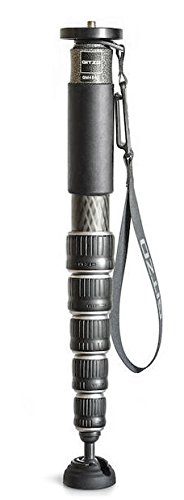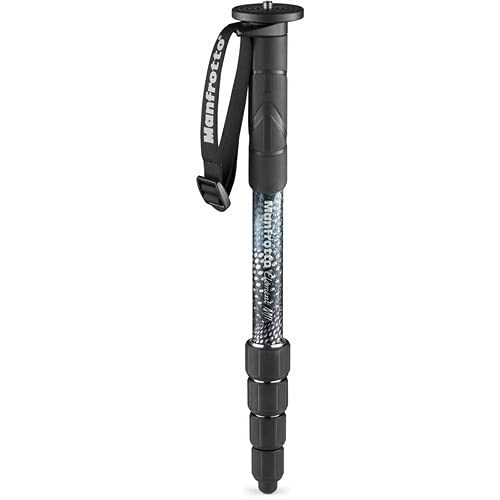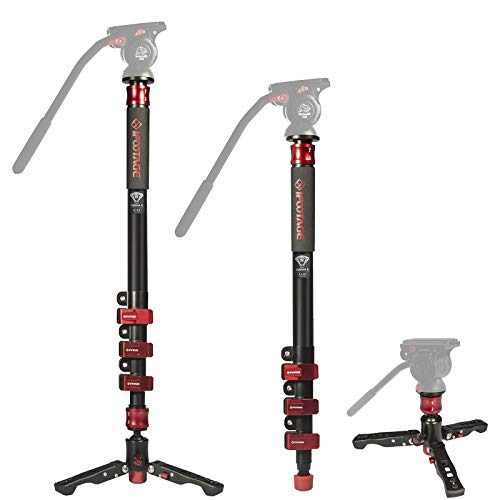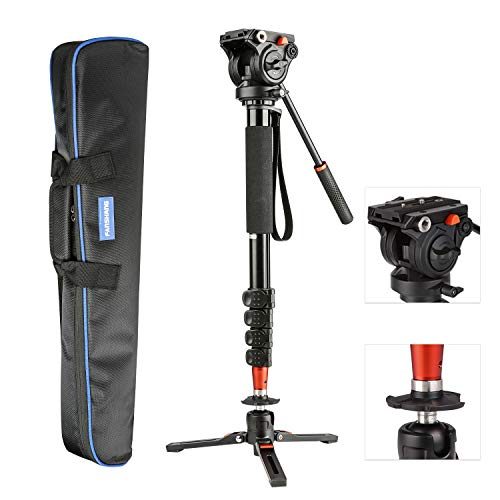Setting up a tripod can take FOREVER. In that time, you might miss your shot! While tripods provide more stability, a fully extended tripod would take up SO MUCH SPACE.
A monopod is quicker, more flexible, and offers easier portability. BUT how do you choose the QUICKEST, MOST FLEXIBLE, AND BEST PORTABILITY?
ENTER the top monopods of 2021 for your camera today! We’ve carefully selected 9 picks just for you!
9 Best Monopods for 2021
Here are our TOP PICKS for the best monopods. With any of these choices, you CANNOT go wrong.
We also included best overall, best value, and best budget options. But do take a look at the other ones as well, as every monopod included here is of EXCELLENT QUALITY!
- Gitzo GM5561T – Best Overall
- SIRUI P-326 – Best Value
- Manfrotto Element – Best Budget Pick
- Manfrotto Compact Photo Monopod Advanced
- Manfrotto XPRO
- Vanguard VEO 2S AM-264TR
- Benro MSD46C SupaDupa Carbon Fiber Monopod
- iFootage Cobra 2 A180
- VILTROX 73″ inch Video Camera Monopod
Gitzo GM5561T – Best Overall
This is a super lightweight professional camera monopod, weighing in at ONLY 1.65 lbs.
It can collapse down to 16.34″. It can also extend up to 61.22″. This is truly one of the best monopods out there that any camera owner would be ECSTATIC to have.
Talk about height advantage, right?!
This carbon fiber monopod has a load capacity of 55.11 lbs., making it rock-hard sturdy, and highly capable of carrying any heavy-duty equipment you need.
Great for those who like to use a large lens!
It features the Anti-Leg Rotation System, which allows it to be set up as fast as 15 seconds! (That’s the same amount of time for cracking 3 eggs! Beginner level of course). You just have to loosen the locking rings simultaneously and pull out the leg.
The G-Lock system ensures that the leg lock is secure and strong. This makes it great for shooting quickly!
With the price of about $400, it can be heavy for most. Though if you can afford it, this would be a great option.
This is the best camera monopod overall due to quality, features, and load capacity.
But of course, for a premium product such as this, you need to pay a premium price. Read on to find more affordable options.
Pros:
- Six leg sections
- Compact and lightweight
- Security and stability ensure great shooting operation
- Heavy load capacity
- Easy and quick set up
Cons:
SIRUI P-326 – Best Value
[amazon fields = “B004QC6VAG” value “thumb” image_size = “large” img_alt = “sirui p-326”]
This is a great price-friendly option.
At just 0.9 lbs., this is definitely one of the most lightweight monopods. For what it can do and how much it can carry, you probably wouldn’t mind carrying it around every time you go shooting.
Its frame is built well, being made of material carbon fiber. It can hold 22 lbs. of weight. So attaching a full-frame DSLR camera with a telephoto lens is HASSLE-FREE.
They use twist locks, which makes it more reliable.
It is made of six sections and extends to a maximum height of 61.4″. What does that mean? IT MEANS it can be comfortably used by photographers of all heights!
It collapses down to just 15.6″, making this a breeeze to carry around. Ready for all the best monopod features? Here’s what Sirui offers:
- It comes with a rubber foot that can be retracted to reveal a spike, which makes it MORE STABLE in softer grounds. This is useful for shooting on soft ground, keeping it from slipping and falling.
- It has a rubber ergonomic hand grip that allows better handling. It also includes a wrist strap and carabiner/compass combo. This makes sure that the support remains firmly in your grasp and you can keep yourself oriented properly.
- You’ll also be able to use it with a head thanks to the 3/8″ screw that it comes with. You can also flip the screw upside down for a 1/4″ tread that will allow you to attach your camera directly to the monopod.
It comes with mostly the same features, but is 1.1 lbs. heavy, and has a lighter load capacity of 17.5 lbs. Aluminum is not as lightweight, but it does help you get a sturdy monopod you can afford.
This is the best monopod for getting a bang for your buck. You get more than what you pay for when you get this. It is one of the best monopods you can get for its price.
Pros:
- Lightweight
- Heavy duty
- Wide height range
- Great value for money
- Ergonomic and comfortable hand grip
- Reversible screws
Cons:
Manfrotto Element – Best Budget Pick
At around $50, the Manfrotto Element is the BEST budget-friendly monopod. This camera monopod is made to be highly durable and high quality.
It’s one very sturdy monopod, made from aluminum, and weighs ONLY 1.1 lbs.
It has Manfrotto’s signature 5-section design with foam lining and a wrist strap for handling. A leg warmer has also been added, which will help with cold weather.
Its maximum height is 59.1″ and folds down to 16.3″. This makes it EASY to carry along.
It holds up to 33 lbs., making it more than capable of carrying your camera, even with a heavy lens.
Setting it up is done with a twist lock.
The mounting plate comes with the standard 1/4″-20 and 3/8″-16 reversible screw. You can switch from a standard rubber foot to a spiked rubber foot. The spiked feet are especially great for soft surfaces.
However, the screw on the base plate is 5/16″ instead of the standard 3/8″. So if you want to use it with an existing tripod foot, you’ll need an adapter.
This is the best monopod if you’re looking for something THAT WON’T BREAK THE BANK.
Pros:
- Budget-friendly, but still high quality
- Lightweight
- Supports up to 32 lbs.
- 5 section design
- Twist locks
Cons:
- Not the standard mounting screw on the base plate.
Manfrotto Compact Photo Monopod Advanced
This is a great entry-level model.
If you have a beginner set up, then the 6.6 lbs. capacity should be enough for you. Just stay away from using a heavy lens. If you use action cameras or entry-level DSLRs, you should be good.
Although it can stretch up to 61.2″, it is amazingly light and compact, being able to go down to 16.3″. This makes it perfect for travel, as it can just be strapped right on your travel bag.
It is also quick to deploy with a quick wheel just under the tripod screw, which allows you to rapidly attach your camera with one hand.
The aluminum body is sturdy enough for most of your photography needs! For practical users, you can’t go wrong with a simple design, especially for first-timers!
Pros:
- Lightweight and compact
- Great entry-level monopod
- Simple and practical choice
- Quick to set up
Cons:
- Only has 6.6 lbs. weight capacity.
Manfrotto XPRO
Say hello to your very own premium camera support that takes up minimal space!
Each monopod in the XPRO range gives you many options. One of them is bound to work for you!
The Manfrotto XPRO aluminum 5-section monopod, however, is worth a closer look.
At just 1.5 lbs. and 16.14″ fully closed, it is very light and compact, therCompaefore making it easy to carry and bring around! Even on travels or long trips!
Although it is light and compact, its maximum height is 55.51″, and can support up to 13 lbs. safely.
If you want something sleek, you can get the carbon fiber version of the XPRO monopod. At 1.37 lbs., it is a little bit lighter than the aluminum version and has MORE REACH.
It’s a little longer fully tucked in, at 19″. However, it extends to about 69.3″. Do note that it has a lighter load limit of 11lbs.
Both monopods have a 3/8″ screw on their support but can be retracted to reveal a 1/4″ screw that lets you mount your camera directly. They also feature quick power locks that allow you to deploy and adjust the legs quickly.
The XPROs are great for photos, but if you’re shooting a video, you should know they are compatible with Manfrotto’s fluid heads as well as the FLUIDTECH base, which will make it a lot more stable.
They also have a wrist strap and a rubber grip, so it’s easy to hold on to.
They are low maintenance, as they don’t require much care, but don’t be fooled! Its durability will serve you for a very long time!
However, for this quality, the price is pretty steep. The aluminum version costs around $100, and the material carbon fiber version is priced over $200.
While there are definitely cheaper options, do note this is an investment and will LAST YOU YEARS. It’s safe to say that the quality is well worth its price. Both the aluminum version and carbon fiber versions are amazing, and you can’t go wrong with either.
These are the best monopod options if you want something safe. You can’t go wrong with a monopod like this!
Pros:
- High quality
- Very long
- Durable -lasts you for years
- Compact design makes it easy to bring around
Cons:
Vanguard VEO 2S AM-264TR
This monopod is easy to identify. It has 3 feet on the bottom!
The tripartite stabilizer is a Vanguard staple. While it makes the monopod a little bulkier, it is highly stable. It can definitely handle a camera with a big lens.
This particular aluminum monopod features brilliantly engineered smooth twist locks and an ergonomic design.
As well as the standard mounts for a camera, it also has a universal smartphone connector. Talk about versatility!
While it’s a little bulkier and heavier than other monopods, the functionality you get greatly makes up for it!
This is the best monopod option for a photographer who wants something very stable. It has the sturdiest build-out of all the other monopods listed.
Pros:
- Lots of functionality
- Highest stability on this list
- Comes with universal smartphone connector
- Ergonomic design
Cons:
- Bulkier and heavier than most monopods
Benro MSD46C SupaDupa Carbon Fiber Monopod
This monopod features a “SupaDupa” strong build, being able to support up to a 40kg, or 88 lbs., load. It can definitely handle a heavy camera and long lenses.
Being this strong is borderline ridiculous. It supports more than quadruple the amount of weight that ANYONE would need. But this also means that it is S-GRADE stable.
It is also light in weight despite being “SupaDupa” strong. It weighs LESS THAN 2 lbs!
The flip locks make it easy to set up as well.
This carbon fiber monster also has six sections and rises to heights of 72″. Despite this AMAZING height reach, its minimum height is 16.9″, making it a great option for travel!
It also comes with the standard, reversible 1/4″-20 and 3/8″-16 screws and a ball joint. A ball joint is great if you want to take action shots.
This monopod comes at around $250. While there are definitely cheaper options, this is basically a SUPER-BUFFED monopod…kind of like the Superman of monopods! If you can afford it, then this is a great option for you.
This is the best monopod for a camera accessory junkie that needs something with SUPERHUMAN STRENGTH to hold all their equipment.
Pros:
- VERY heavy duty
- Weighs less than 2 lbs
- Durable
- Wide height range
Cons:
iFootage Cobra 2 A180
This monopod features an enormous maximum height of 70.9″ and ultra-secure adjustable feet, forming the perfect base for 360-degree footage.
It has a solid aluminum construction, four leg sections, and a maximum capacity of 17.6 lbs.
However, it’s pretty heavy, weighing in at 3.3 lbs. And it’s pretty bulky, still measuring 27.5″ when packed. So if you’ll be traveling a lot, this isn’t for you.
But as long as you’re up to carrying it, it is a great monopod that will serve you well for shooting any photo or video you want.
This is the best monopod for someone who wants to get a lot of overhead shots.
Pros:
- Impressive maximum height
- Solid quality
- Extra secure and stable
Cons:
VILTROX 73″ inch Video Camera Monopod
This monopod has a very durable build. It extends to a whopping 72.8″, which is phenomenal for overhead shots.
It just may be the TALLEST on our list!
Weighing at just 1.8 lbs. and retracting to just 26″, it has a comfortable size. While it is not super compact, it is definitely comfortable enough to bring around.
A wrist strap and foam grip help you to get a FIRM GRIP.
It features a quick release plate with 1/4″ and 3/8″ screws and a removable tripod leg section for stable mounting on flat surfaces.
You can detach the leg sections with a swivel.
The weight capacity, however, is not the highest. It is only 13.2 lbs., which is a little disappointing considering how great its other features are.
Though it should work just fine as long as you don’t mount heavy lenses on it. It should carry basic mirrorless cameras pretty well.
It has everything you need in a monopod. So there’s not much to complain about here.
This is the ideal monopod for someone who wants something basic and simple.
Pros:
- Large maximum height
- Lightweight
- Fast and smooth pan and tilt
- Easy locking
- Removable tripod legs
Cons:
Things to Look Out for in a Monopod
Before deciding what to get for your photography needs, there are a few important things to look out for.
You want to pick something that gives you good quality for the photography you need, at a decent price.
For example, if you’re a sports photographer, you’d want to invest more in this than others would. For the everyday photographer, something simple would do.
Here are the basics you should look out for.
Strength and Stability
Your monopod should be able to support the weight of your entire setup. So make sure you check the maximum carrying capacity of the monopod you’re planning on buying.
Something that can make a monopod more stable would be flip out feet. Some monopods offer that feature, so if added stability is important, look out for that. One downside to this though, is that the overall setup can get bulkier.
Rule of thumb: The heavier the weight of the monopod, the more stable it will be.
However, the light ones have their advantages as well.
Minimum and Maximum Height
Each monopod has a different height capacity. Get a monopod that has a maximum height that you’re satisfied with! Whether it’s at eye level or overhead, a monopod can be useful in shooting at that perfect angle.
Also, take note of how small it can be compressed. This affects how easy it is to carry around.
Though no worries if it can’t be compressed that small, you can use it as a walking stick!
Weight
We already touched on the importance of height on portability.
But we also should take note of the weight of the entire monopod. The lighter it is, the more portable it will be. The heavier it is, the more stable it will be.
Generally, carbon fiber is lighter than aluminum.
Locks
Monopod leg sections have a twist or flip locks. Twist locks are more secure, while flip locks are faster. It depends on you which one you prefer! Consider how secure you want your monopod to be.
Grip and Wrist Strap
The top of the monopod should have a grip. It’s up to you what kind of grip you would like, foam or textured rubber.
Monopods with foam grips tend to be CHEAPER. A wrist strap would also greatly help with grip!
Material: Aluminum and Carbon Fiber
While not a HUGE factor, this may be important to some photographers. Typically monopods are made from either aluminum or carbon fiber.
This can affect the weight and durability of the monopod.
- Carbon fiber tends to be lighter, but also usually costs more.
- Aluminum is a very sturdy option and is great for those on a budget.
Personally, we’re not very picky about our equipment. We believe you use what you can afford. So our personal pick would be aluminum due to it being more budget-friendly.
Leg Sections
If you want something easier to set up, you’ll want a monopod with fewer leg sections. But if portability is your main concern, something with collapsible leg sections is easier to carry around.
FAQs
Are Monopods Good for Photography?
Monopods are extremely useful for photography. They offer stability while not taking up as much space as a tripod would.
Photographers like that they fold up compactly and can be carried into crowded places and events.
So in short, yes. They can be great for your photography needs!
Are Monopods Good for Video?
A monopod is a great tool for videographers who need extra stability for their production.
They’re also compact and lightweight, so it’s easy to travel with.
What is a Camera Monopod Used For?
It’s mainly used to help a photographer or videographer keep a steady hand.
- Monopods support cameras so that the photo or video taken is steady. It is especially useful with taking photos using slower shutter speeds or with long focal lenses.
- For video shooting, it reduces camera shake, making videos steadier.
Although these are all things that a tripod can do, a monopod is MORE COMPACT and QUICKER to set up.
Nowadays, you can also find pretty sturdy monopods.
Are Monopods for Cameras Effective?
Monopods are great for videographers who want smoother panning, and fixed shots for a video. It is also effective as a support for photographers, especially those in the sports photography industry.
Can a Monopod Stand on its Own?
Yes. Monopods have little feet on the bottom that allow it to stand on its own.
In fact, monopods can be pretty sturdy and stand even with a camera attached to it. Usually, it’s the lighter weight ones that may have issues doing this.
Should I Get a Monopod or a Tripod?
Tripods can shoot longer exposures due to their more stable base. They are also more steady than a monopod. In terms of stability, the tripod definitely wins.
However, with three legs that have to be set up, they aren’t the best for quick shots. The weight is significantly more than that of a monopod as well.
A monopod is generally more affordable. They are also better for getting quicker shots. Another advantage that monopods have over bulky tripods, is that it takes up less space. This makes them more ideal for crowded spaces.
So it really depends on what your needs are. Sports photographers can benefit greatly from a monopod.
Related
Final Thoughts
While a tripod is a great accessory to have, sometimes it’s just way too bulky! A monopod can handle the weight of your camera and is more portable and convenient.
There are many you can get that aren’t on this list. But trust us, with any of the ones listed here, you cannot go wrong.
What was your favorite? Let us know in the comments section below!












